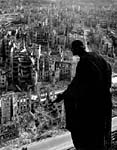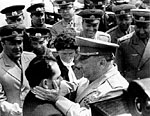 The
Fotokinoverlag's massive archiving of images began during the 1960s,
and functioned primarily to valorize and authenticate the ideological
mandate of the ZKF. The archive was the heart of East Germany's evolving
socialist aesthetic, its history as well as its future, and an artist's
relationship to it defined his or her position in relation to socialist
culture. The archive also provided the state with an apparatus for
observation of an artist's production over an extended period of time.
By assuming the right to re-present images under changing circumstances
(as Richard Peter, Sr.'s photographs of the aftermath of the Dresden
firestorm were differently presented in various historical and artistic
contexts, for example), Die Fotografie's editors also assumed
the power to alter the meaning of those images over time. The
Fotokinoverlag's massive archiving of images began during the 1960s,
and functioned primarily to valorize and authenticate the ideological
mandate of the ZKF. The archive was the heart of East Germany's evolving
socialist aesthetic, its history as well as its future, and an artist's
relationship to it defined his or her position in relation to socialist
culture. The archive also provided the state with an apparatus for
observation of an artist's production over an extended period of time.
By assuming the right to re-present images under changing circumstances
(as Richard Peter, Sr.'s photographs of the aftermath of the Dresden
firestorm were differently presented in various historical and artistic
contexts, for example), Die Fotografie's editors also assumed
the power to alter the meaning of those images over time.  Thus,
the Fotokino Archive was not merely an accumulation of social knowledge
about East Germany, but a powerful engine of socialist propaganda
and control. Thus,
the Fotokino Archive was not merely an accumulation of social knowledge
about East Germany, but a powerful engine of socialist propaganda
and control. The
ZKF exercised its authority during the 1960s and '70s through its
direction of Die Fotografie and the Fotokino Archive. Most
photographers, wishing to stay employed in their chosen field, complied
with Die Fotografie's aesthetic agenda. Many, however, found
ways to work around it. A photographer might present a critique of
a foreign country, showing poverty in the USA or strikes in West Germany
for example, but not of comparable problems in East German society.
East German artists were also held up to a higher standard than their
foreign colleagues.  Chemical
pollution and social isolation were safe subjects for Czech photographers
as early as 1973. Nude photography by East German artists was characterized
by its implicit statement of physical health, while nudes from Poland
were technically experimental and frequently erotic. The policy of
different standards for different artists contributed to the instability
of socialist aesthetics, and to the growing division between photographers
who served the goals of the state and those who sought a higher purpose
for their art. Chemical
pollution and social isolation were safe subjects for Czech photographers
as early as 1973. Nude photography by East German artists was characterized
by its implicit statement of physical health, while nudes from Poland
were technically experimental and frequently erotic. The policy of
different standards for different artists contributed to the instability
of socialist aesthetics, and to the growing division between photographers
who served the goals of the state and those who sought a higher purpose
for their art.
|

 Thus,
the Fotokino Archive was not merely an accumulation of social knowledge
about East Germany, but a powerful engine of socialist propaganda
and control.
Thus,
the Fotokino Archive was not merely an accumulation of social knowledge
about East Germany, but a powerful engine of socialist propaganda
and control.  Chemical
pollution and social isolation were safe subjects for Czech photographers
as early as 1973. Nude photography by East German artists was characterized
by its implicit statement of physical health, while nudes from Poland
were technically experimental and frequently erotic. The policy of
different standards for different artists contributed to the instability
of socialist aesthetics, and to the growing division between photographers
who served the goals of the state and those who sought a higher purpose
for their art.
Chemical
pollution and social isolation were safe subjects for Czech photographers
as early as 1973. Nude photography by East German artists was characterized
by its implicit statement of physical health, while nudes from Poland
were technically experimental and frequently erotic. The policy of
different standards for different artists contributed to the instability
of socialist aesthetics, and to the growing division between photographers
who served the goals of the state and those who sought a higher purpose
for their art.